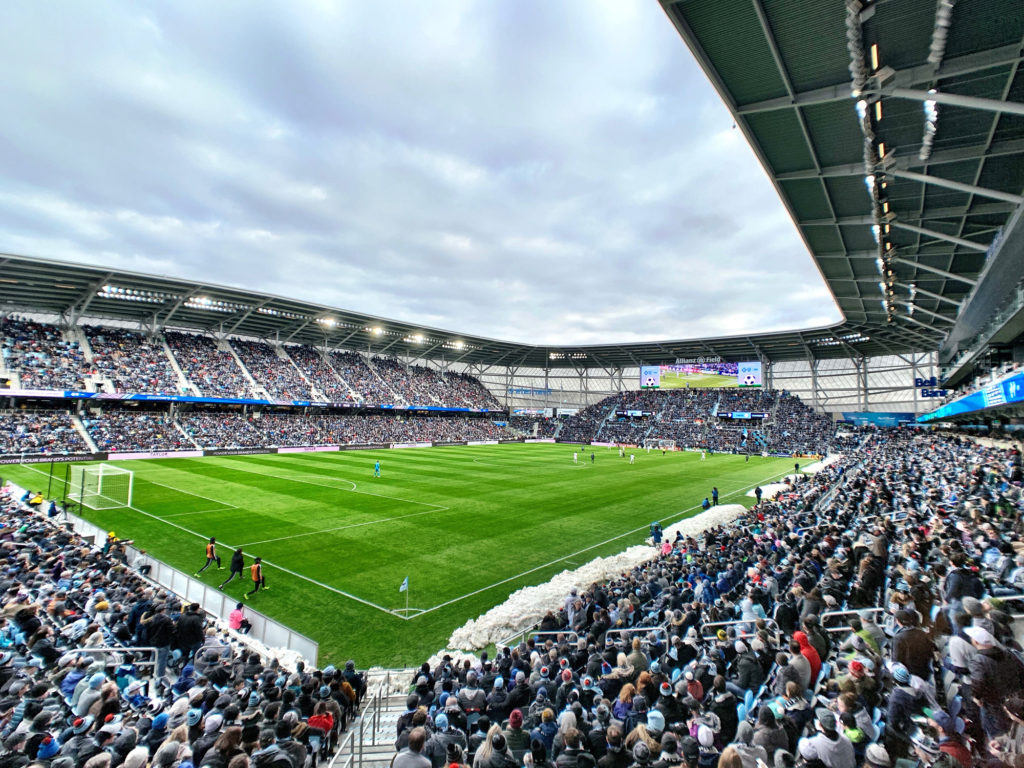
With the regular season ending with Decision Week matches, 2019 MLS attendance ended up on a strong note, with almost 300,000 fans attending 12 matches.
Here are both season and Week 31 totals for 2019 MLS attendance, as of Oct. 6:
| Team | Av. | Total | Gms | 2018 | YOY | Week 31 | |
| 1 | Atlanta United FC | 52,510 | 892,663 | 17 | 53,002 | -0.01 | 44,617 |
| 2 | Seattle Sounders | 40,247 | 684,192 | 17 | 40,641 | -0.01 | 47,297 |
| 3 | FC Cincinnati | 27,336 | 464,720 | 17 | NA | NA | |
| 4 | Portland Timbers | 25,218 | 428,706 | 17 | 21,144 | 0.19 | 25,218 |
| 5 | Toronto FC | 25,048 | 425,816 | 17 | 26,628 | -0.06 | 23,692 |
| 6 | LA Galaxy | 23,205 | 394,477 | 17 | 24,444 | -0.05 | |
| 7 | Orlando City SC | 22,761 | 386,940 | 17 | 23,866 | -0.05 | 22,433 |
| 8 | LAFC | 22,251 | 378,265 | 17 | 22,042 | 0.01 | 22,537 |
| 9 | NYC FC | 21,107 | 358,820 | 17 | 23,211 | -0.09 | |
| 10 | Minnesota United | 19,723 | 335,291 | 17 | 23,902 | -0.17 | |
| 11 | Vancouver Whitecaps | 19,514 | 331,745 | 17 | 21,946 | -0.11 | 18,378 |
| 12 | San Jose Earthquakes | 18,781 | 319,272 | 17 | 19,032 | -0.01 | |
| 13 | Sporting KC | 18,601 | 316,211 | 17 | 19,950 | -0.07 | |
| 14 | Real Salt Lake | 18,121 | 308,050 | 17 | 18,605 | -0.03 | |
| 15 | D.C. United | 17,744 | 301,644 | 17 | 17,635 | 0.01 | 18,732 |
| 16 | New York Red Bulls | 17,281 | 293,769 | 17 | 18,601 | -0.07 | |
| 17 | Philadelphia Union | 17,111 | 290,883 | 17 | 16,518 | 0.04 | 18,525 |
| 18 | NE Revolution | 16,737 | 284,535 | 17 | 18,347 | -0.09 | |
| 19 | Montreal Impact | 16,171 | 274,904 | 17 | 18,569 | -0.13 | 15,022 |
| 20 | Houston Dynamo | 15,674 | 266,464 | 17 | 16,906 | -0.07 | 21,777 |
| 21 | Columbus Crew | 14,856 | 252,555 | 17 | 12,447 | 0.19 | |
| 22 | FC Dallas | 14,842 | 252,313 | 17 | 15,512 | -0.04 | 15,623 |
| 23 | Colorado Rapids | 14,284 | 242,833 | 17 | 15,333 | -0.07 | |
| 24 | Chicago Fire | 12,324 | 209,516 | 17 | 14,806 | -0.17 | |
| TOTALS | 21,310 | 8,694,584 | 408 | 21,873 | -0.03 | 293,851 | |
| WEEKLY AV. | 24,488 |
The league experienced a rise in total attendance thanks to the addition of FC Cincinnati, but 2019 saw a 3 percent decline from 2018 on a per-match average. Some of the decline is understandable (Minnesota United moving to a smaller venue represents a 1 percent dip on its own), and we expect other declines to be addressed in the offseason–and some, like the move of the Chicago Fire from SeatGeek Stadium to Soldier Field, are already underway.
